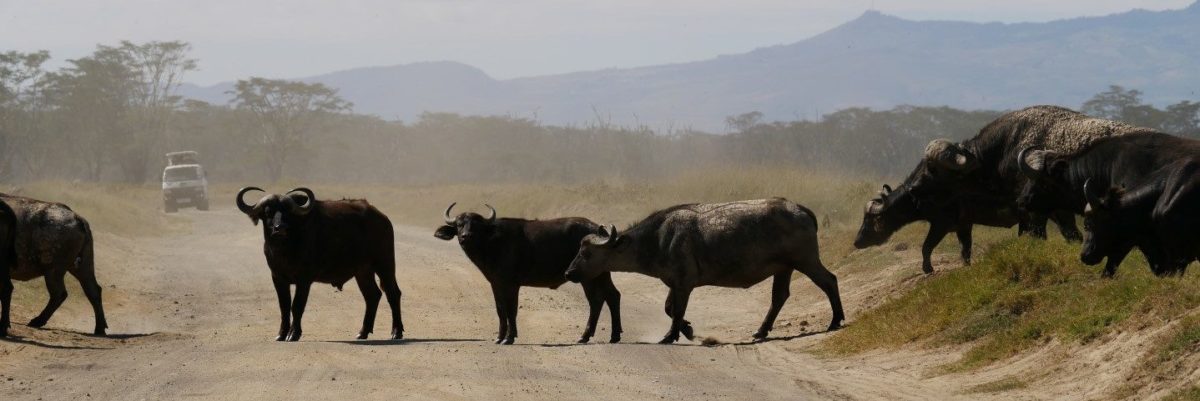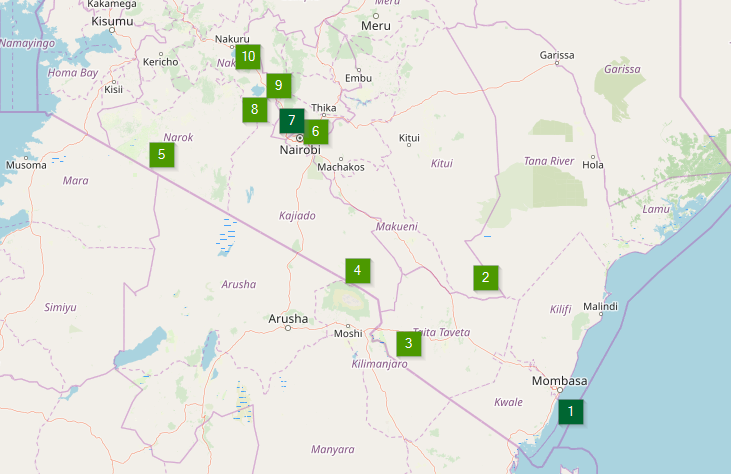
General
If you think about going on a safari, Kenya will come across as a potential destination rather soon than late. In Kenya you have the opportunity to see the Big 5 and all other interesting animals. There are a variety of national parks. I’ll give you a brief description of the parks I’ve been to on the detail pages and show you some photos, so you can see what awaits you.
I have been to Kenya twice, first time in May (rainy season) and second time in September (dry season). It was a great experience both times. Also in the rainy season, I had relatively good luck with the weather. Except for one day, in the 2 weeks I never had prolonged rain. I also saw almost every animal. Nevertheless I would clearly recommend going between July and October during the dry season.
Why? It looks nice when it’s green everywhere in the rainy season, but you will not even believe how well the animals can hide in the grass. A lion can be 5m off the road in the grass and when he lies down, he is no longer visible. Sooner or later, you still will see almost all the animals, as the guides also inform each other if they spot something rare, but overall you can see significantly fewer animals than in the dry season. In the dry season the grass is almost non-existent. You can see hundreds of meters. Also there is a high chance that more animals will be found near the decreasing number of waterholes. In addition, between July and September, the the “Great Migration” takes place. During that time large zebra and wildebeest herds come to the Masai Mara.
The price to go in the rainy season is of course better and you can save several hundred dollars. Also there are significantly less other tourists on the way. That makes the safari a bit more private, because not everywhere else minibuses drive around you.
Beside the national parks, Kenya also has a great coastline with beautiful sandy beaches. These are much emptier in rainy season, too.
In addition to the safaris and a bit of beach vacation, I also visited a coffee farm. Photos and a description to the parks, the coast and the coffee farm can be found on the detail pages.
Bookings
The easiest and probably best way if you go for the first time is, to book a package holiday. I have done that the first time and I would do it again this way. You have no organization effort, can get to know something and about the country. If you find a good deal, then it’s not so much more expensive compared to a self organized travel. But even if you don’t want to do a package holiday, you can book your tours from home.
The second time I was traveling to Kenya, it was without a package. Especially to reach the parks, where I was not the first time. But from the beginning the travel did not start as I imagined it.
You may know it from other countries, booking tours simply on site at local agencies, where it is also much cheaper… you should forget about that idea directly. I was in Nairobi, there is no such thing as a main square. So I just went to a mall in the tourist district, but nothing to book any tours. Ok, maybe in another – nothing. Googled for agencies, went to two addresses, at both addresses was not even an office. I have asked in the hotel – no, we don’t offer tours but I can give you a phone number and e-mail address of an agency. I got in touch with their contact, but they offered only very bad prices.
In the end I was sitting at the hotel bar and searched the Internet for tours and booked there. Luckily going on a tour or safari even on short notice was not a problem … But I could have done it at home already.
I have booked then a Nairobi National Park trip on the TripAdvisor site Viator.com. I found my visit to the coffee farm on AirBnB and I booked a multi-day safari tour on https://www.safaribookings.com/ from a local agency. Safaribookings.com is in general very good, as there are also a lot of information about the different parks available.
In Kenya Uber is available and being used a lot also from the locals. With Uber you have the advantage that you pay normal prices and not 500% tourist surcharge. I have used it several times, for routes between the hotel and the airport and for my visit to the coffee farm. It always worked without any problems. You can also use taxis, but better check with Uber which price you would pay there. Makes negociation a lot easier if you can say, thanks, I better take Uber, that only ??$… then they will give you the same price but you can avoid waiting.
For hotels you can use the common websites. But look at hotels.com and booking.com, depending on the hotel, the one or the other may have special offers.
Travel medicine
If you have not been a globetrotters yet, then you will probably need some immunizations. So arrange an appointment with your doctor early. He will check together with you, which vaccinations you need and will probably tell you that malaria prophylaxis is advisable. The malaria risk in Kenya, especially on the coast is really high.
Take your own mosquito net with you, then you can sleep more relaxed. Sometimes you arrive somewhere in your room and see the holes in the net or there is no net at all. Also take mosquito repellent with you.
In the end, everything is not too bad. But as I said, make sure to get an appointment in time with your doctor, so you have time for the vaccinations. And do not drink water from the tap, but only from bottles.
Country and People
The infrastructure in Kenya is not everywhere as good as we know it from other countries. Major roads are indeed paved, but sometimes on the way to national parks, there are only unpaved roads. So that certain routes take much longer time and when it starts to rain. Such a road can quickly turn into a mud track.
Kenya is a poor country and if you have not been to such a country before, you will be appealed of the living conditions in small mud huts with corrugated iron roofs that you will see on the roadside. There will be people on the beach, sitting in front of the hotels, hoping to earn a bit money from the tourists or to get something. If you are going to Kenya, take not only your favorite shirts. Take the things from your closet that have been lying there for a long time. On your last day just leave them there. You do the people a favor and know that the things arrive and directly have more space in the suitcase for souvenirs.
In Kenya people speak Swahili or English or a hybrid. As Kenya used to be an English colony, as a tourist you can generally communicate well in English. In tourism, there are also Kenyans who speak other languages and even the people on the beach have learned some other languages.
For the safari, it should be noted that some of the accommodations are not powered 24 hours a day. So maybe there is only 2h electricity in the morning and in the evening. The sockets are type G – the UK standard, so you might need a travel adapter. It is best to take a power strip with you, so that you can charge everything in parallel.
Wi-Fi is not always present in the safari lodges or just because a Wi-Fi is available, it does not mean that it works. But I’m sure you will survive a few days without it. Otherwise get a SIM card, which is recommended if you do not have an full organized round trip and you still have to book your activities and hotels for the next few days. I had Safaricom, which was working quite good almost everywhere.
Safety
On the subject of safety, read the safety and security Information from the Foreign Office of your country.
On safaris and on the hotel grounds I never had a bad feeling. Special care should be taken in the cities of Mombasa and Nairobi, where you should not be out at night. Even during the day you should not walk with visible valuables. In front of the big shopping malls, hotels and restaurants there are security controls like at the airport. Also, most houses and hotels have high fences around. It gives you a good feeling inside. The same time you might think, if everything is so well secured, it must have a reason. Slums and similar neighborhoods should be avoided, but in the tourist districts you certainly do not have to lock yourself in the hotel and during the day. You can also walk 10 minutes to the mall, than 20 minutes by taxi in a traffic jam.
Photography
For the safari definitely take your tele lens with you. If you do not have one, but were thinking about buying one, then before the safari trip would be the right time. I have almost only used my 100-300mm (35mm camera equivalent of 200-600mm) lens on my Lumix GX85. Since you never know when an animal comes around the corner and does not want to miss it, you will almost never change the lens. And of course you want to shoot with your best zoom to capture the animals as large as possible. Depending on the park it can also be quite dusty on the way and you do not want all the dirt on the sensor.
Most people are not equipped with 2 cameras, therefore it makes sense to use the mobile phone or an action camera for the wide-angle landscape photos. Nowadays the deliver good pictures in the wide-angle range within good light. So do not forget to charge the phone, even if you might not need it, because there is not always and everywhere Wi-Fi and electricity.
Your tripod can stay at home, it is anyway too inflexible for a safari. You need to be fast, if the leopard is visible, so you will take a lot of freehand photos. As a little helper, you can take a “bean bag tripod” with you, which you can put on the vehicle roof.
Keep in mind that you are shooting a moving subject with a high focal length. The exposure time must be as short as possible to not getting shaky pictures. When I’m not photographing against the sun, drop the idea of keeping ISO as low as possible. Even with ISO 800, the cameras generally deliver noise-free images and it reduces your risk for shaky pics.
Be sure to bring enough memory cards and batteries with you. If you have the opportunity to charge batteries via USB, definitely take a power bank with you. In the accommodation electricity is partly turned off at night and you only have only 2h in the morning and evening to charge. You did not want to have an empty battery when the lion eats a zebra.
Detail pages
I show you the highlights of my Kenya trip in detail and with lots of pictures. The links to the detail pages are directly below the overview map. The map should give you an overview where in Keya the described places are.










10 – Lake Nakuru National Park
